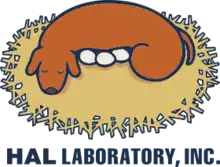HAL Laboratory
HAL Laboratory, Inc.,[lower-alpha 2] formerly shortened as HALKEN (derived from its native name), is a Japanese video game developer founded on February 21, 1980. While independent, it has been closely tied with Nintendo throughout its history. The company is headquartered in Chiyoda, Tokyo, and it also has a building at Kai, Yamanashi.[4] The company got its name because "each letter put them one step ahead of IBM".[5] The company is most famous for their work on the Kirby and Mother series, as well as the first two Super Smash Bros. games.
 Logo used since December 1998, named "Inutamago", depicts an "unexpected bond" with a dog incubating three eggs | |
Native name | 株式会社ハル研究所 |
|---|---|
Romanized name | Kabushiki gaisha Haru Kenkyūjo |
| Type | Kabushiki gaisha |
| Industry | Video games |
| Genre | |
| Founded | 21 February 1980 in Kanda, Chiyoda, Tokyo, Japan |
| Founder | Mitsuhiro Ikeda |
| Headquarters | Kanda Square, 2-2-1 Kandanishiki-cho, , Japan |
Number of locations | 2 studios[lower-alpha 1] (2019) |
Key people |
|
| Products |
|
Number of employees | 195 (2020) |
| Subsidiaries | Warpstar, Inc. (50%) |
| Website | www |
| Footnotes / references [1][2][3] | |
The logo, dubbed Inutamago (Japanese: 犬たまご "Dog Eggs") depicts a dog incubating eggs, which has been in use since 1998.
History
HAL Laboratory started off making games for the MSX system and the Commodore VIC-20.[6] After financial strain brought on from the development of Metal Slader Glory (1991) for the Famicom,[7] Nintendo offered to rescue HAL from bankruptcy on the condition that HAL employee Satoru Iwata was appointed as its president, which he became between 1993 and 2000.[8] Iwata later became president of Nintendo.
The logo 'Inutamago' was commissioned in 1998 by then HAL Laboratory president, Satoru Iwata. This was handled by Shigesato Itoi who went through many different ideas. He went with the theme of 'an unexpected bond...one that brings the birth of something new' which would lead to the idea of a dog incubating eggs in a nest. The actual design was created by Mr. Akiyama of HAL. The design was indoctrinated by HAL Laboratory in 1998 although the reception at first was lukewarm.[9]
In many of its games during the early to mid-1990s it used the name HALKEN, derived from their Japanese name. Some of its early titles were also released as HAL America Inc. (HAI), a North American subsidiary of the company led by Yash Terakura and based in Beaverton, Oregon, USA.[10]
In August 2001, HAL Laboratory and Nintendo established Warpstar, Inc. in a joint venture (where each part owns 50% of the company) with the objective to manage the Kirby IP along with its copyright, which the decision for the creation of the company was mainly for Kirby: Right Back at Ya! anime series. After the end of the anime, the company still exists and now works with license and supervision of the character in games, merchandise and other media.[4][11]
For years, the company's development center at Tokyo was located within the eighth floor of the Nintendo Tokyo Prefecture Building which itself is located Nihombashi, Chuo-ku, Tokyo, but in August 2003, the company announced that a restructuration was happening and that the development center at the building would be relocated to HAL's main office building in Kanda Suda-cho, Chiyoda-ku, Tokyo. While this change happened on the Tokyo-based company, the Yamanashi part of HAL was unaffected by the changes of the company.[12]
In 2017, HAL Laboratory announced that they would develop and self-publish games for mobile devices with the brand HAL Egg and focusing on completely new characters and franchises, with different types of design than what the developers of the company usually do. The first title launched by them was Part Time UFO.[13]
In 2020, HAL Laboratory updated their employee numbers from 169 to 195 and the company came back to the new Nintendo Tokyo Building with its main office and the Tokyo development studio, being on the same building along with Nintendo EPD Tokyo, Nintendo PTD Tokyo, 1-Up Studio and Game Freak like a keiretsu.[14] With that said, the Yamanashi studio continues on the same location as before and was not transferred to the Nintendo building.
List of games
Family Computer Disk System
- Gall Force: Eternal Story (1986)
- Eggerland (1986)
- Fire Bam (1988)
- Famicom Grand Prix II: 3D Hot Rally (1988)
- Eggerland: Souzouhe no Tabidachi (1989)
Nintendo Entertainment System
- Lot Lot – (1985) JP
- Othello – (1986) JP, (1988) NA
- Air Fortress – (1987) JP, (1989) NA, PAL
- Vegas Dream – (1988) JP, (1990) NA
- Rollerball – (1988) JP, (1990) NA
- Millipede – (1988) JP, NA
- Adventures of Lolo – (1989) NA, (1991) EU
- Adventures of Lolo 2 – (1990) JP, NA, (1991) PAL
- Adventures of Lolo 3 – (1990) JP, (1991) NA, (1992) EU
- New Ghostbusters II – (1990) JP, (1991) PAL
- Kabuki Quantum Fighter – (1991) NA (1992) EU
- Metal Slader Glory – (1991) JP
- Day Dreamin' Davey – (1992) NA
- Kirby's Adventure – (1993) JP, NA, PAL
- Satsui no Kaisou: Power Soft Renzoku Satsujin Jiken
- Skyscraper
- Jumbo Ozaki no Hole in One Professional
- Uchuu Keibitai SDF
- Joust
- Defender II
- World Rally Championship
- Joy Radar (RF hardware unit for wireless Audio/Video from the game unit to the monitor)
Game Boy
- Revenge of the 'Gator – (1989) JP, NA, EU
- Shanghai – (1989) JP, (1990) NA
- Ghostbusters II – (1989) EU (1990) JP, NA
- Trax – (1991) EU, JP, NA
- Kirby's Dream Land – (1992) JP, NA, EU
- Kirby's Pinball Land – (1993) JP, NA, EU
- Adventures of Lolo – (1994) JP (1995) EU
- Vegas Stakes – (1995) NA, EU
- Kirby's Dream Land 2 – (1995) JP, NA, EU
- Kirby's Block Ball – (1995) JP, NA, EU
- Kirby's Star Stacker – (1997) JP, NA, EU
Super NES
- HAL's Hole in One Golf (1991)
- SimCity (1991)
- Hyper Zone (1991)
- Arcana (1992)
- NCAA Basketball aka Super Dunk Shot (in Japan) World League Basketball (in Europe) (1992)
- Vegas Stakes (1993)
- Alcahest (1993)
- EarthBound (Mother 2 in Japanese) (1994)
- Kirby's Dream Course (1994)
- Kirby's Avalanche (1995)
- Kirby Super Star (1996)
- Shigesato Itoi's No. 1 Bass Fishing (1997)
- Kirby's Dream Land 3 (1997)
- Kirby no Kirakira Kizzu (1998)
- Metal Slader Glory: Director's Cut (2000)
Nintendo 64
- Pokémon Stadium (1998) JP
- Pokémon Snap (1999)
- Pokémon Stadium (1999)
- Super Smash Bros. (1999)
- SimCity 64 (2000)
- Shigesato Itoi's No. 1 Bass Fishing: Definitive Edition (2000)
- Kirby 64: The Crystal Shards (2000)
- Pokémon Stadium 2 (2000)
- Mother 3 – (Cancelled)
Game Boy Color
- Pokemon Pinball – (1999) JP, NA, EU
- Kirby Tilt 'n' Tumble – (2000) JP (2001) NA
GameCube
- Super Smash Bros. Melee (2001)
- Kirby Air Ride (2003)
- Kirby Tilt n Tumble 2 (Cancelled)
- Kirby (Cancelled)
Game Boy Advance
- Kirby: Nightmare in Dream Land – (2002) JP, NA (2003) EU
- Kirby & The Amazing Mirror (Co-developed with Flagship) – (2004) JP, NA, EU
- Mother 3 (Co-developed with Brownie Brown) – (2006) JP
- Battland – (Cancelled)
- Luna Blaze – (Cancelled)
Nintendo DS
- Kirby Canvas Curse – (2005) JP, NA, EU (2006) AUS
- Common Sense Training – (2006) JP
- Kirby Squeak Squad (Co-developed with Flagship) – (2006) JP, NA (2007) EU, AUS
- Pokémon Ranger (Co-developed with Creatures Inc) – (2006) JP, NA, AUS (2007) EU
- Kirby Super Star Ultra – (2008) JP, NA, AUS (2009) EU
- Picross 3D – (2009) JP (2010) NA, EU
- Face Pilot (DSiWare) – (2010) JP, NA, AUS, EU
- Kirby Mass Attack – (2011) JP, NA, AUS, EU
Wii
- Minna no Joushiki Ryoku TV (TV Friend Guide Channel)
- Kirby's Epic Yarn (Co-developed with Good-Feel) (2010) JP, NA (2011) AU, EU
- Kirby's Return to Dream Land (2011)
- Kirby's Dream Collection (2012)
Nintendo 3DS
- Face Raiders (2011)
- Kirby: Triple Deluxe (2014)
- Kirby Fighters Deluxe (2014)
- Dedede's Drum Dash Deluxe (2014)
- BoxBoy! (2015)
- Picross 3D: Round 2 (2015)
- BoxBoxBoy! (2016)
- Kirby: Planet Robobot (2016)
- Bye-Bye BoxBoy! (2017)
- Team Kirby Clash Deluxe (2017)
- Kirby's Blowout Blast (2017)
- Kirby Battle Royale (2017)
- Kirby’s Extra Epic Yarn (2019) (Co-developed with Good-Feel)
Wii U
- Kirby and the Rainbow Curse (2015)
Nintendo Switch
- Kirby Star Allies (2018)
- Super Kirby Clash (2019) (Co-developed with Vanpool)
- BoxBoy! + BoxGirl! (2019)
- Kirby Fighters 2 (2020) (Co-developed with Vanpool)
- Part Time UFO (2020)
Commodore VIC-20
- Alien
- Avenger (Space Invaders clone)
- Jelly Monsters (Pac-Man clone)
- Jupiter Lander (Lunar Lander clone)
- Money Wars
- Pin Ball (Cutie Q clone)
- Poker
- Radar Rat Race (Rally-X clone)
- Road Race (Night Driver clone)
- Slot Machine
- Star Battle (Galaxian clone programmed by Satoru Iwata; ex-CEO of Nintendo and Hal Laboratory)
Commodore MAX Machine[15]/Commodore 64
- Avenger
- Billiards
- Bowling
- Clowns
- Gorf
- Jupiter Lander
- Kickman
- Le Mans
- Max Basic
- Mini Basic Max
- Mole Attack
- Money Wars
- Music Composer
- Music Machine
- Omega Race
- Pinball Spectacular
- Poker
- Radar Rat Race
- Road Race
- Ski (aka Slalom)
- Super Alien
- Wizard of Wor
Coleco Vision
- Mr. Chin
MSX
- Balance
- Butamaru Pants
- Cue Star
- Dragon Attack
- Dunk Shot
- Eggerland Mystery
- Eggerland 2
- Fruit Search
- Gall Force
- Heavy Boxing
- Hole in One
- Hole in One Professional
- Inside the Karamaru
- Inspecteur Z
- Mobile Planet Stillus/The Roving Planet Stillus
- Mr. Chin
- Pachipro Densetsu
- Picture Puzzle
- Rollerball
- Space Maze Attack
- Space Trouble
- Step Up
- Super Billiards
- Super Snake
- Swimming Tango
- Tetsuman
- The Roving Planet Styllus
MSX2
- Hole in One Special
- Zukkoke Yajikita Onmitsudoutyuu
- Mr. Ninja – Ashura's Chapter
Windows
- Eggerland Episode 0: Quest of Rara
- Egger Land for Windows 95
- Revival! Eggerland
Mobile
- Part Time UFO (2017)
- Housuu de Shoubu! Kame Sanpo (2019)
Computer Animation
- Pokémon: The Movie 2000 (CG Tool Development)
Notes
References
- https://www.hallab.co.jp/eng/company/profile/
- https://www.hallab.co.jp/eng/company/history/
- https://www.hallab.co.jp/eng/company/symbol/
- "Corporate Info". HAL Laboratories. Retrieved 17 September 2007.
- Madden, Orla (30 November 2012). "Iwata Explains Where The Name HAL Laboratory Came From". nintendolife.com. Nintendo Life. Retrieved 16 October 2016.
- "What was Japan for Commodore?". commodore.ca. 16 February 2004. Archived from the original on 26 August 2018. Retrieved 16 October 2016.
- Crimmins, Brian (21 November 2017). "Why Does HAL Laboratory Only Make Nintendo Games?". Waypoint. Archived from the original on 2 September 2018. Retrieved 1 July 2018.
- "Satoru Iwata – 1999 Developer Interview". Used Games (in Japanese). 1999. (Translation Archived 12 July 2016 at the Wayback Machine)
- "Satoru Iwata Wasn't Hot on the Earthbound Creator's Logo for HAL Labs". USGamer.net. Retrieved 17 April 2020.
- "Yash Terakura joins Throwback Entertainment as Chief Technology Officer". GamesIndustry.biz. 11 May 2007. Retrieved 16 October 2016.
- "Iwata Asks: Kirby's Epic Yarn". Nintendo of Europe GmbH. Retrieved 9 February 2020.
- Bayer, Glen (6 October 2005). "HAL Laboratory: Company Profile". nsidr. Archived from the original on 16 June 2018. Retrieved 9 February 2020.
- Romano, Sal (22 August 2017). "HAL Laboratory launches smartphone game brand HAL Egg, first title due out this fall in Japan". Gematsu. Archived from the original on 25 August 2017. Retrieved 9 February 2020.
- https://www.hallab.co.jp/company/profile/
- "The Ultimax Collection". Commodore 64 Preservation Project. 26 November 2008. Retrieved 19 May 2012.
